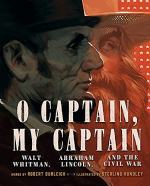
|
| Name: _________________________ | Period: ___________________ |
This test consists of 15 multiple choice questions and 5 short answer questions.
Multiple Choice Questions
1. Which details in the second stanza evoke a patriotic occasion?
(a) The flag and bugle.
(b) The crowd and the shore.
(c) The bouquets and wreaths.
(d) The captain and the bells.
2. In the second quatrain of the second stanza, what becomes clear about the speaker's state of mind?
(a) He is afraid that he is in some way responsible for the captain's death.
(b) He hopes to hide the captain's death from the crowd.
(c) He is actually asleep and only dreaming of the captain's death.
(d) He has not fully accepted the captain's death.
3. Line 6, "O the bleeding drops of red," is an example of which technique?
(a) Oxymoron.
(b) Imagery.
(c) Conceit.
(d) Metonymy.
4. Line 4, "While follow eyes the steady keel, the vessel grim and daring," contains examples of which techniques?
(a) Synecdoche and personification.
(b) Simie and alliteration.
(c) Alliteration and synecdoche.
(d) Personification and simile.
5. What does the phrase "swaying mass" refer to (line 12)?
(a) The crowd.
(b) The ship.
(c) The flag.
(d) The captain.
6. Which technique is evident in the phrase "for you the flag is flung" (line 10)?
(a) Assonance.
(b) Sibilance.
(c) Cacophony.
(d) Alliteration.
7. Which technique is evident in line 10, "Rise up—for you the flag is flung—for you the bugle trills"?
(a) Antithesis.
(b) Anaphora.
(c) Antistrophe.
(d) Antimetabole.
8. In context, the word "fearful" in line 1 indicates that the trip was which of the following?
(a) Full of frightening obstacles.
(b) The cause of the captain's death.
(c) A metaphor for an internal struggle.
(d) A bad idea from the beginning.
9. In context, the literal meaning of the word "rack" in line two is which of the following?
(a) A metal rod used for hanging things.
(b) Storm or upheaval.
(c) A thorough sorting or sifting.
(d) Battle or confrontation.
10. What type of rhyme is employed in line 20, "From fearful trip the victor ship comes in with object won"?
(a) Identical rhyme.
(b) Eye rhyme.
(c) Near rhyme.
(d) Internal rhyme.
11. Line 5, " But O heart! heart! heart!" is an example of which technique?
(a) Paradox.
(b) Aphorism.
(c) Apostrophe.
(d) Euphemism.
12. What does it mean that the people are "exulting"?
(a) They are drinking and celebrating.
(b) They are quietly watchful.
(c) They are cheering excitedly.
(d) They are crying out in grief.
13. By which other term, besides "Captain," does the speaker address the captain of the ship?
(a) Brother.
(b) Leader.
(c) Master.
(d) Father.
14. Where is the ship in the beginning of the poem?
(a) Just coming into port.
(b) Just leaving the port.
(c) On the open sea.
(d) Docked in the port.
15. The poem's title and first line contain an example of which technique?
(a) Simile.
(b) Personification.
(c) Synechdoche.
(d) Apostrophe.
Short Answer Questions
1. What is a "keel" (line 4)?
2. Who is the author of "O Captain! my Captain!"?
3. What is the most accurate way to describe the poem's stanza form?
4. Which term describes the poem's repeated use of the phrases "O Captain! My Captain!" (lines 1 and 9) and "fallen cold and dead" (lines 8, 16, and 24)?
5. Who is the speaker of the poem?
|
This section contains 527 words (approx. 2 pages at 300 words per page) |

|




